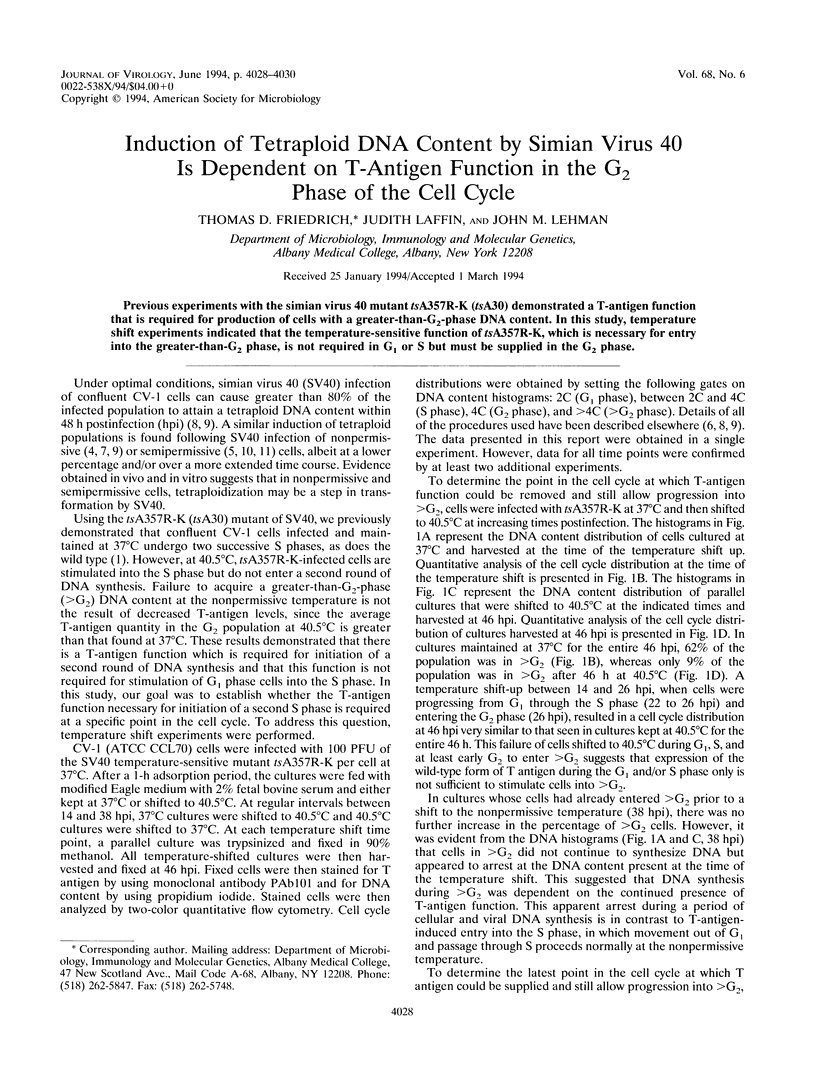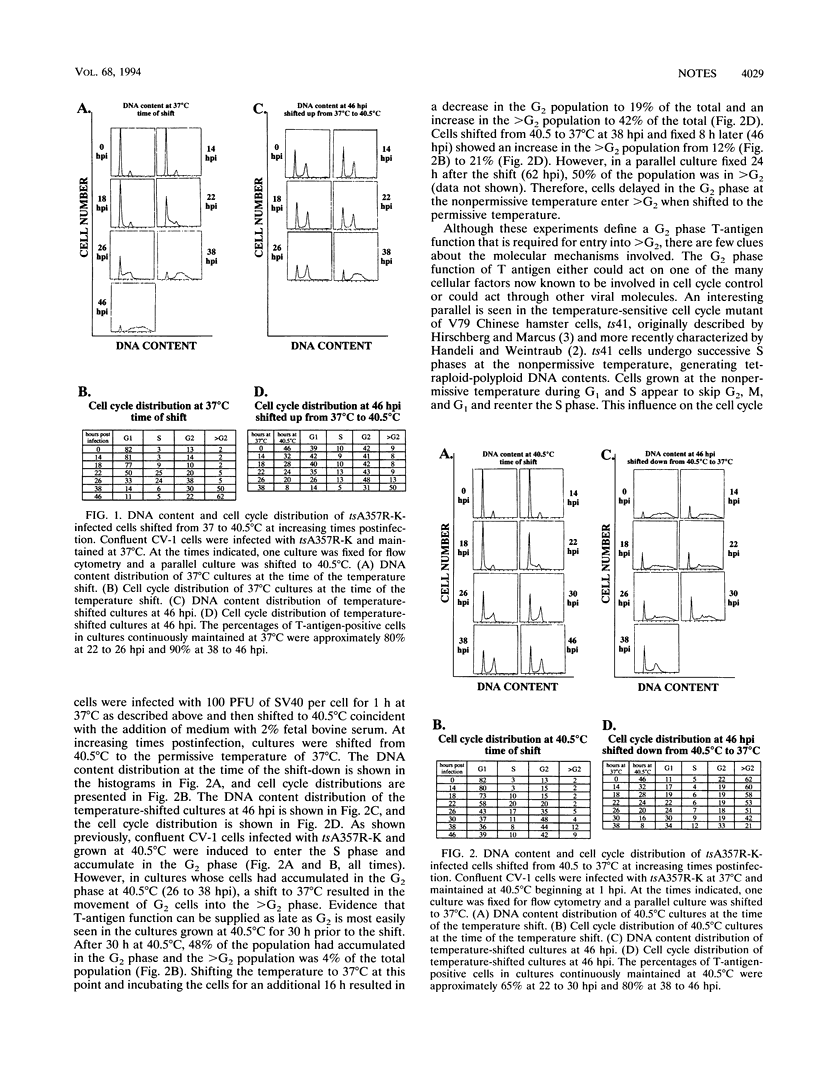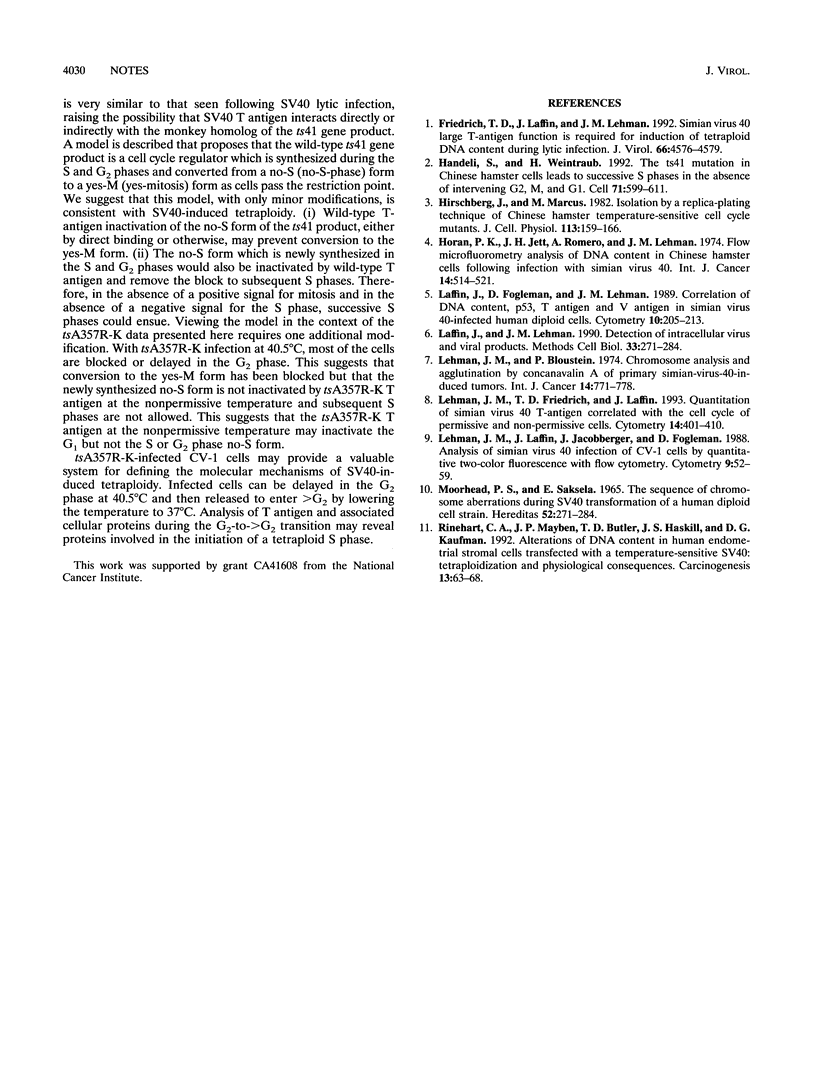Abstract
Previous experiments with the simian virus 40 mutant tsA357R-K (tsA30) demonstrated a T-antigen function that is required for production of cells with a greater-than-G2-phase DNA content. In this study, temperature shift experiments indicated that the temperature-sensitive function of tsA357R-K, which is necessary for entry into the greater-than-G2 phase, is not required in G1 or S but must be supplied in the G2 phase.
Full text
PDF


Selected References
These references are in PubMed. This may not be the complete list of references from this article.
- Friedrich T. D., Laffin J., Lehman J. M. Simian virus 40 large T-antigen function is required for induction of tetraploid DNA content during lytic infection. J Virol. 1992 Jul;66(7):4576–4579. doi: 10.1128/jvi.66.7.4576-4579.1992. [DOI] [PMC free article] [PubMed] [Google Scholar]
- Handeli S., Weintraub H. The ts41 mutation in Chinese hamster cells leads to successive S phases in the absence of intervening G2, M, and G1. Cell. 1992 Nov 13;71(4):599–611. doi: 10.1016/0092-8674(92)90594-3. [DOI] [PubMed] [Google Scholar]
- Hirschberg J., Marcus M. Isolation by a replica-plating technique of Chinese hamster temperature-sensitive cell cycle mutants. J Cell Physiol. 1982 Oct;113(1):159–166. doi: 10.1002/jcp.1041130125. [DOI] [PubMed] [Google Scholar]
- Horan P. K., Jett J. H., Romero A., Lehman J. M. Flow microfluorometry analysis of DNA content in Chinese hamster cells following infection with simian virus 40. Int J Cancer. 1974 Oct 15;14(4):514–521. doi: 10.1002/ijc.2910140411. [DOI] [PubMed] [Google Scholar]
- Laffin J., Fogleman D., Lehman J. M. Correlation of DNA content, p53, T antigen, and V antigen in simian virus 40-infected human diploid cells. Cytometry. 1989 Mar;10(2):205–213. doi: 10.1002/cyto.990100212. [DOI] [PubMed] [Google Scholar]
- Laffin J., Lehman J. M. Detection of intracellular virus and viral products. Methods Cell Biol. 1990;33:271–284. doi: 10.1016/s0091-679x(08)60531-2. [DOI] [PubMed] [Google Scholar]
- Lehman J. M., Bloustein P. Chromosome analysis and agglutination by concanavalin a of primary simian-virus-40-induced tumors. Int J Cancer. 1974 Dec 15;14(6):771–778. doi: 10.1002/ijc.2910140611. [DOI] [PubMed] [Google Scholar]
- Lehman J. M., Friedrich T. D., Laffin J. Quantitation of simian virus 40 T-antigen correlated with the cell cycle of permissive and non-permissive cells. Cytometry. 1993;14(4):401–410. doi: 10.1002/cyto.990140409. [DOI] [PubMed] [Google Scholar]
- Lehman J. M., Laffin J., Jacobberger J. W., Fogleman D. Analysis of simian virus 40 infection of CV-1 cells by quantitative two-color fluorescence with flow cytometry. Cytometry. 1988 Jan;9(1):52–59. doi: 10.1002/cyto.990090109. [DOI] [PubMed] [Google Scholar]
- Moorhead P. S., Saksela E. The sequence of chromosome aberrations during SV 40 transformation of a human diploid cell strain. Hereditas. 1965;52(3):271–284. doi: 10.1111/j.1601-5223.1965.tb01960.x. [DOI] [PubMed] [Google Scholar]
- Rinehart C. A., Mayben J. P., Butler T. D., Haskill J. S., Kaufman D. G. Alterations of DNA content in human endometrial stromal cells transfected with a temperature-sensitive SV40: tetraploidization and physiological consequences. Carcinogenesis. 1992 Jan;13(1):63–68. doi: 10.1093/carcin/13.1.63. [DOI] [PubMed] [Google Scholar]


